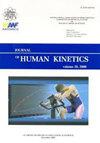优秀手球运动员频闪训练的电生理证据:视觉诱发电位研究
IF 1.9
3区 医学
Q2 SPORT SCIENCES
引用次数: 0
摘要
频闪训练增强知觉认知和运动技能;然而,这种适应背后的神经生理机制尚不完全清楚。本研究旨在探讨为期六周的频闪训练对优秀手球运动员视觉通路电导率的影响,特别是与他们对视网膜位置和观看条件的视觉处理有关。这项研究包括22名手球运动员,他们被随机分为实验组和对照组。两组都进行了特定于手球的原位任务,但只有实验组进行了频闪训练。在为期六周的训练前后和四周后,在三种观看条件(主视、非主视和双眼)和两个视网膜位置(中央凹外视觉和中央凹视觉)下,使用P100内隐时间和振幅测量的视觉诱发电位记录对参与者进行了三次评估。结果显示,优势眼的P100隐性时间在中央凹外视觉(F2,40 = 5.20, p = 0.010, ηp2 = 0.206)、中央凹外双眼视觉(F2,40 = 3.32, p = 0.046, ηp2 = 0.142)和优势眼中央凹视觉(F2,40 = 4.07, p = 0.025, ηp2 = 0.169)中具有显著的TIME vs. GROUP效应。频闪训练通过减少优势眼和双眼视觉的P100内隐时间,特别是中央凹外视觉,显著改善了早期视觉加工。与长期相比,这种改善在短期内更为明显。本文章由计算机程序翻译,如有差异,请以英文原文为准。
Electrophysiological Evidence of Stroboscopic Training in Elite Handball Players: Visual Evoked Potentials Study
Stroboscopic training enhances perceptual cognition and motor skills; however, neurophysiological mechanisms underlying this adaptation are not fully understood. This study aimed to investigate the effects of a six-week stroboscopic training program on the conductivity of the visual pathway in elite handball players, specifically related to their visual processing of retinal location and viewing conditions. The study included 22 handball players who were randomly assigned to an experimental or a control group. Both groups performed handball-specific in-situ tasks, but only the experimental group underwent stroboscopic training. Participants were assessed three times using visually evoked potential recordings measured by P100 implicit time and amplitude under three viewing conditions (dominant eye, non-dominant eye, and binocular) and two retinal locations (extra-foveal and foveal vision) before and after the six-week training period, and again four weeks later. The results showed a significant TIME vs. GROUP effect of P100 implicit time for the dominant eye in extra-foveal vision (F2,40 = 5.20, p = 0.010, ηp2 = 0.206), extra-foveal binocular viewing (F2,40 = 3.32, p = 0.046, ηp2 = 0.142), and dominant eye foveal vision (F2,40 = 4.07, p = 0.025, ηp2 = 0.169). Stroboscopic training significantly improved early visual processing by reducing the P100 implicit time for the dominant eye and binocular vision, particularly in extra-foveal vision. The improvements were more noticeable in the short compared to the long term.
求助全文
通过发布文献求助,成功后即可免费获取论文全文。
去求助
来源期刊

Journal of Human Kinetics
医学-运动科学
CiteScore
4.80
自引率
0.00%
发文量
83
审稿时长
3 months
期刊介绍:
The Journal of Human Kinetics is an open access interdisciplinary periodical offering the latest research in the science of human movement studies. This comprehensive professional journal features articles and research notes encompassing such topic areas as: Kinesiology, Exercise Physiology and Nutrition, Sports Training and Behavioural Sciences in Sport, but especially considering elite and competitive aspects of sport.
The journal publishes original papers, invited reviews, short communications and letters to the Editors. Manuscripts submitted to the journal must contain novel data on theoretical or experimental research or on practical applications in the field of sport sciences.
The Journal of Human Kinetics is published in March, June, September and December.
We encourage scientists from around the world to submit their papers to our periodical.
 求助内容:
求助内容: 应助结果提醒方式:
应助结果提醒方式:


